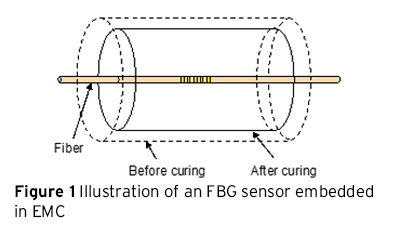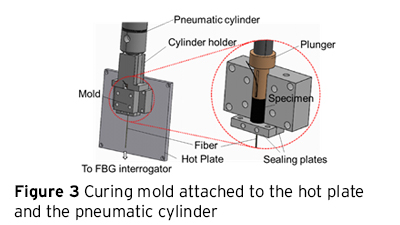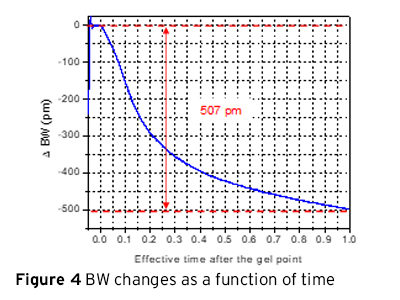Part II: How to measure effective cure shrinkage?
This article is the second part in a three-part series. Click here to read Part I.
 A fiber Bragg grating (FBG) is employed as a strain sensor to measure the effective cure shrinkage of the epoxy molding compound (EMC). As illustrated in Figure 1, the FBG sensor is embedded in a cylindrically-shaped EMC specimen. After the gel point, the effective cure shrinkage of EMC compresses the FBG in the axial direction, and a Bragg Wavelength (BW) shift occurs.
A fiber Bragg grating (FBG) is employed as a strain sensor to measure the effective cure shrinkage of the epoxy molding compound (EMC). As illustrated in Figure 1, the FBG sensor is embedded in a cylindrically-shaped EMC specimen. After the gel point, the effective cure shrinkage of EMC compresses the FBG in the axial direction, and a Bragg Wavelength (BW) shift occurs. The BW shift after the gel point is illustrated in Figure 2. The BW is continuously measured while the specimen cures. The effective cure shrinkage is then determined from the governing equation that defines the relationship between the BW shifts and the effective cure shrinkage. 

The specimen is fabricated using a custom-designed steel mold assembly, which is shown schematically in Figure 3. The inset shows a plunger that applies the required mold pressure to the specimen. 

The optical fiber (diameter of 125 μm) is inserted through a small through-hole drilled in the center of an EMC pellet. A large mechanical pressure has to be applied during curing. The mechanical plunger achieves the required pressure (7 MPa).
For the actual test, the pressure was applied immediately after the specimen was heated to the pre-heating temperature, where the EMC became viscous fluid. The pressure was removed as soon as the specimen reached the curing temperature, i.e., before the gel point.
The results from the test are shown in Figure 4, where the BW shift is shown as a function of time. It is important to note that the BW shift is zero for a short initial period. 

This shift is a clear indication that the FBG responded only after the gel point. The total BW shift was 507 pm, and the corresponding effective cure shrinkage was 0.032%. As discussed in Part I, the effective cure shrinkage should be used for the cure-induced warpage prediction of packages after transfer molding.
For more information about warpage prediction, please contact Prof. Bongtae Han.
Top